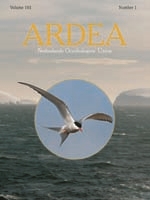In this study we examined the effect of different livestock grazing treatments on breeding bird densities in a salt marsh habitat. To avoid an experiment on the large scale needed to directly measure grazing effects on bird densities, we followed a two-step approach. First, we measured vegetation micro-patterns (mosaic of lower vegetation and taller patches at 4×4 m) around Common Redshank Tringa totanus and Eurasian Oystercatcher Haematopus ostralegus nests and at random sites paired with these nests sites to judge suitability of micro-patterns for nest building. Secondly, we measured micro-patterns at 120 permanent plots in five different experimental grazing treatments to determine how grazing affects micro-patterns. We compared low stocking density of both cattle and of horses, high stocking density of cattle and of horses, and intermittent grazing with a high stocking density of cattle (i.e. yearly intervals of grazing and no grazing). Redshank and Oystercatcher nests occurred in sites with taller vegetation and more pronounced micro-patterns than found at random sites. Paddocks grazed with low densities of livestock or with a high density intermittent grazing treatment had micro-patterns preferred by the birds. We conclude that Redshanks and Oystercatchers may benefit in terms of potential nest sites from grazing at low livestock densities or at intermittent stocking densities through effects of grazing on micro-patterns in the vegetation.
How to translate text using browser tools
1 January 2014
Spatial Diversity in Canopy Height at Redshank and Oystercatcher Nest-Sites in Relation to Livestock Grazing
Freek S. Mandema,
Joost M. Tinbergen,
Bruno J. Ens,
Jan P. Bakker

Ardea
Vol. 101 • No. 2
January 2014
Vol. 101 • No. 2
January 2014
biodiversity
cattle grazing
horse grazing
patchiness
Salt marsh
spatial heterogeneity
vegetation structure




